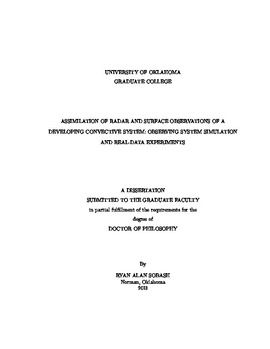| dc.description.abstract | Convective-scale observing system simulation experiments (OSSEs) and real-data experiments were performed to study the impact of radar and surface observations on analyses and forecasts of convective systems using the Weather Research and Forecasting (WRF) model with an ensemble Kalman filter (EnKF). The OSSEs were performed to assess the impact of covariance localization of radar data on the analyses of a developing convective system. Increasing the horizontal localization and decreasing the vertical localization produced analyses with the smallest RMSE for most of the state variables. The convective mode of the analyzed system also had an impact on the localization results. During cell mergers, larger horizontal localization improved the results. Prior state correlations between the observations and state variables were used to construct reverse cumulative density functions (RCDFs) to identify the correlation length scales for various observation-state pairs. The OSSE with the smallest RMSE employed localization cutoff values that were similar to the horizontal and vertical length scales of the prior state correlations, especially for observation-state correlations above 0.6. Vertical correlations were restricted to state points closer to the observations than in the horizontal, as determined by the RCDFs. Further, the microphysical state variables were correlated with the reflectivity observations on smaller scales than the three-dimensional wind field and radial velocity observations.
As a complement to the OSSEs, the WRF model and the EnKF were again employed to produce analyses and forecasts for the 29 May 2012 convective episode. This event produced very large hail (> 4” diameter), 80 mph wind gusts, and a brief tornado, near and within the OKC metropolitan area, with estimated losses totaling 500 million dollars. Surface data, including data from surface mesoscale networks (i.e. mesonets), were assimilated at 5-minute intervals between 18 UTC and 21 UTC. Both surface and WSR-88D data were assimilated at 5-minute intervals between 21 UTC and 23 UTC, following convection initiation (CI). Several 50-member, 6-hour, ensemble forecasts were produced between 18 UTC and 23 UTC.
The frequent assimilation of surface data, especially the use of mesonet data, improved the forecast of CI timing and placement within the domain, especially for convection developing along a surface dry line. Surface data assimilation reduced a surface moisture bias that was present due to model error. Experiments where mesonet data were withheld, or where surface data were assimilated less frequently, produced less accurate forecasts of CI and possessed larger surface moisture errors. The improved surface state at 21 UTC also led to changes in the forecast convective mode after 00 UTC. The ability of sub-hourly assimilation of mesonet data to improve forecasts of CI has not been previously documented.
After two hours of both radar and surface data assimilation, the 23 UTC ensemble forecast was able to capture much of the observed convective evolution, including the tracks of several long-lived supercells. Surface data assimilation played a significant role in producing the successful forecasts. Forecasts from an experiment that assimilated only radar data contained several large errors due to a poor representation of the mesoscale environment. Some parts of the forecast were especially sensitive to the assimilation of reflectivity observations and the vertical localization of those observations. Finally, using innovation statistics, several reflectivity biases were identified in the analyses due to errors in the microphysics parameterization, the reflectivity forward operator, and biases in the environmental wind profile. Together, the OSSEs and real-data experiments herein provide a benchmark for the accuracy and ability of EnKF systems to produce analyses for more complex convective events. | en_US |
